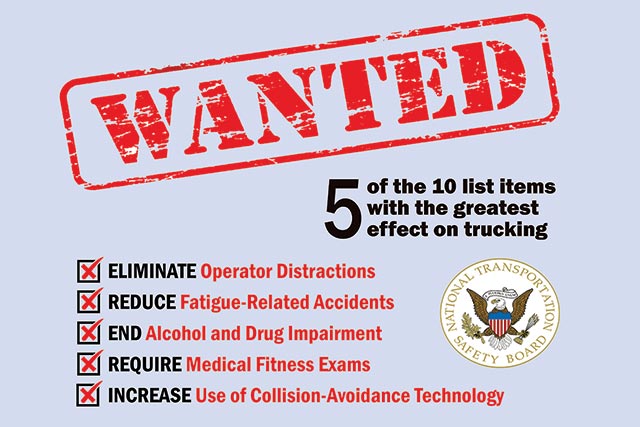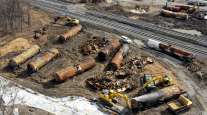NTSB List Targets Many Trucking Issues; Hazmat Shipping Is Newcomer to Top 10

This story appears in the Nov. 21 print edition of Transport Topics.
The National Transportation Safety Board unveiled its 10 Most Wanted List of Transportation Safety Improvements for 2017-2018 on Nov. 14, with the independent agency adding shipping safety for hazardous materials in place of the completion of rail-safety initiatives.
Also on the list were: eliminating distractions for operators; reducing fatigue-related accidents; ending alcohol and drug impairment; requiring medical fitness exams; and increasing implementation of collision- avoidance technology, all of which are trucking industry goals.
Rounding out the list were strengthening vehicle occupant protection; expanding event recorder use; improving rail-transit safety oversight; and preventing the loss of in-flight control for general aviation.
NTSB said the list is a consensus of what board members think are the areas in transportation safety with the greatest opportunity for change and to save lives. The items are not listed in order of importance.
“Transportation safety is not a destination, but a continuing journey, and our efforts to improve safety must never stop,” NTSB Chairman Christopher Hart said. “It takes a concerted and continuing effort by industry, government and private citizens to save lives.
“For 26 years, the Most Wanted List has been our road map from lessons learned to lives saved. It represents actions which, if taken, will save lives, prevent injuries and reduce property damage in all modes of transportation.”
The Commercial Vehicle Safety Alliance was gratified that many of its priorities made the list.
“They’re properly aligned with the challenges we’re facing in the industry today,” CVSA Executive Director Collin Mooney said. “A number of them we are tackling directly through such programs as Operation Safe Driver and a Community Safety Grant that we were awarded from the [U.S.] Pipeline and Hazardous Materials Safety Administration on Oct. 1 to assist with the roadside enforcement of hazardous materials.”
CVSA represents North American law enforcement agencies that inspect trucks and buses.
Instead of issuing the list annually as has been the rule, NTSB moved to a two-year cycle to give transportation stakeholders more time to make the suggested changes.
The National Safety Council applauded the NTSB choices.
“The NTSB’s recommendations are based on decades of investigations — their work uncovers both the proximate causes and the contributing factors that result in thousands of fatalities … every year,” said NSC President Deborah Hersman, a former NTSB chairwoman. “As 95% of transportation deaths occur on our nation’s roadways, if left unchecked, these issues will continue killing thousands of roadway users each year.”
American Trucking Associations also supported the list selections.
“ATA is pleased that a number of our safety priorities — including eliminating distraction, ending drug- and alcohol-impaired driving, improving medical fitness standards and harnessing the power of safety technology — made it on to NTSB’s Most Wanted List this year,” spokesman Sean McNally said. “ATA and its members spend more than $9 billion a year on safety, including work on these issues.”
The Owner-Operator Independent Drivers Association found fault with the list. OOIDA spokeswoman Norita Taylor noted that the list “appears to be missing truck driver training and crash worthiness.”
Jackie Gillan, president of the Advocates for Highway and Auto Safety, called for action on NTSB’s goals.
“We know the problems, we have the solutions but we lack political leadership,” Gillan said. “Lifesaving federal vehicle safety standards and state traffic safety laws to protect motorists, pedestrians, motorcycle riders and children either fall short of enactment or are snubbed by lawmakers. The NTSB’s Most Wanted List is a critical reminder of what actions are needed if we are serious about reversing the skyrocketing death and injury toll on our streets and roads.”
Highway fatalities increased by 7.2% from 2014 to 2015, the largest rise since before NTSB was founded in 1967. What’s more, such traffic deaths rose an additional 10.4% in the first half of 2016, according to National Highway Traffic Safety Administration data.
NTSB is a five-member board, although there is one vacancy. The main job of board members and staff is to investigate major transportation accidents, especially plane crashes, but it also makes safety recommendations.




